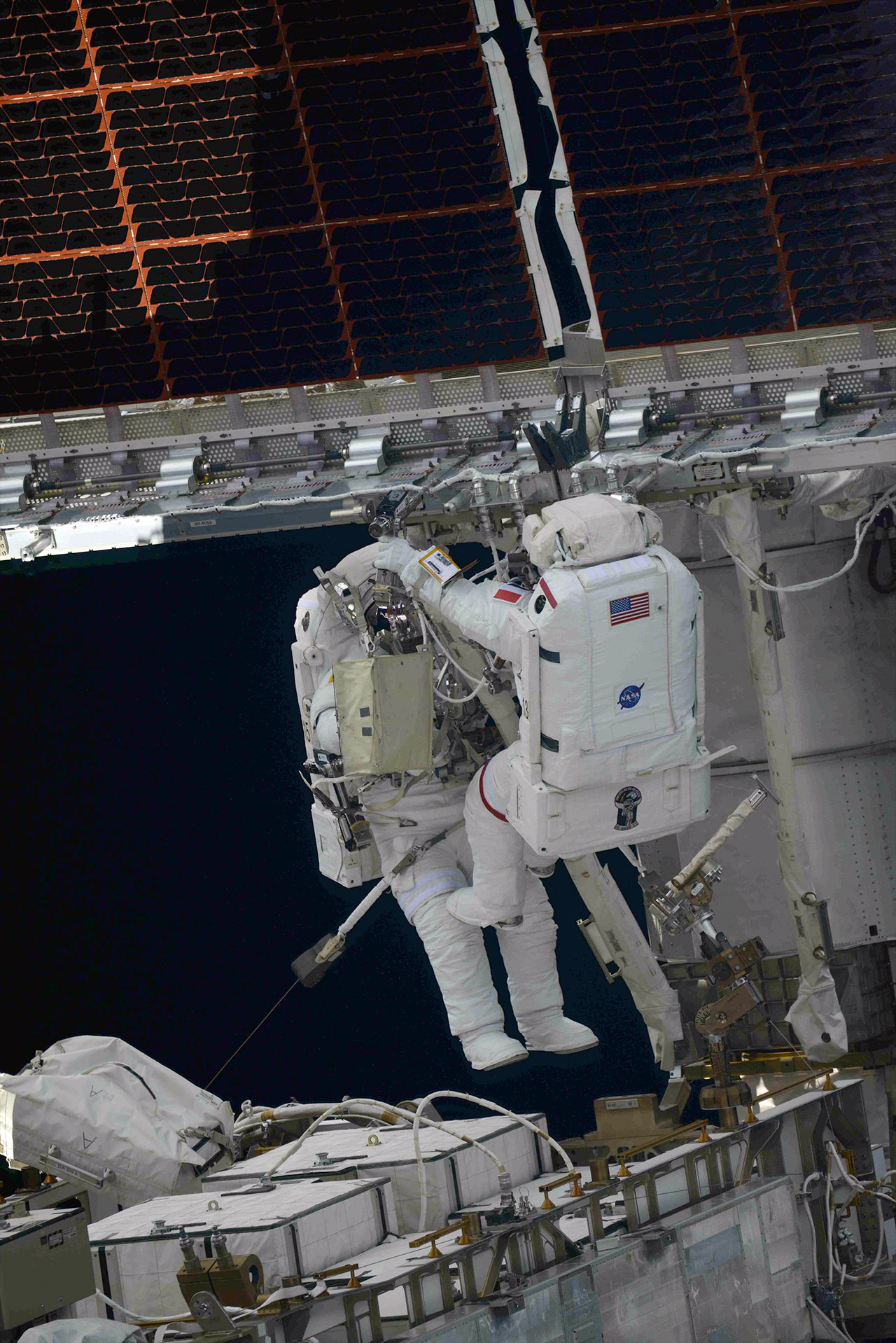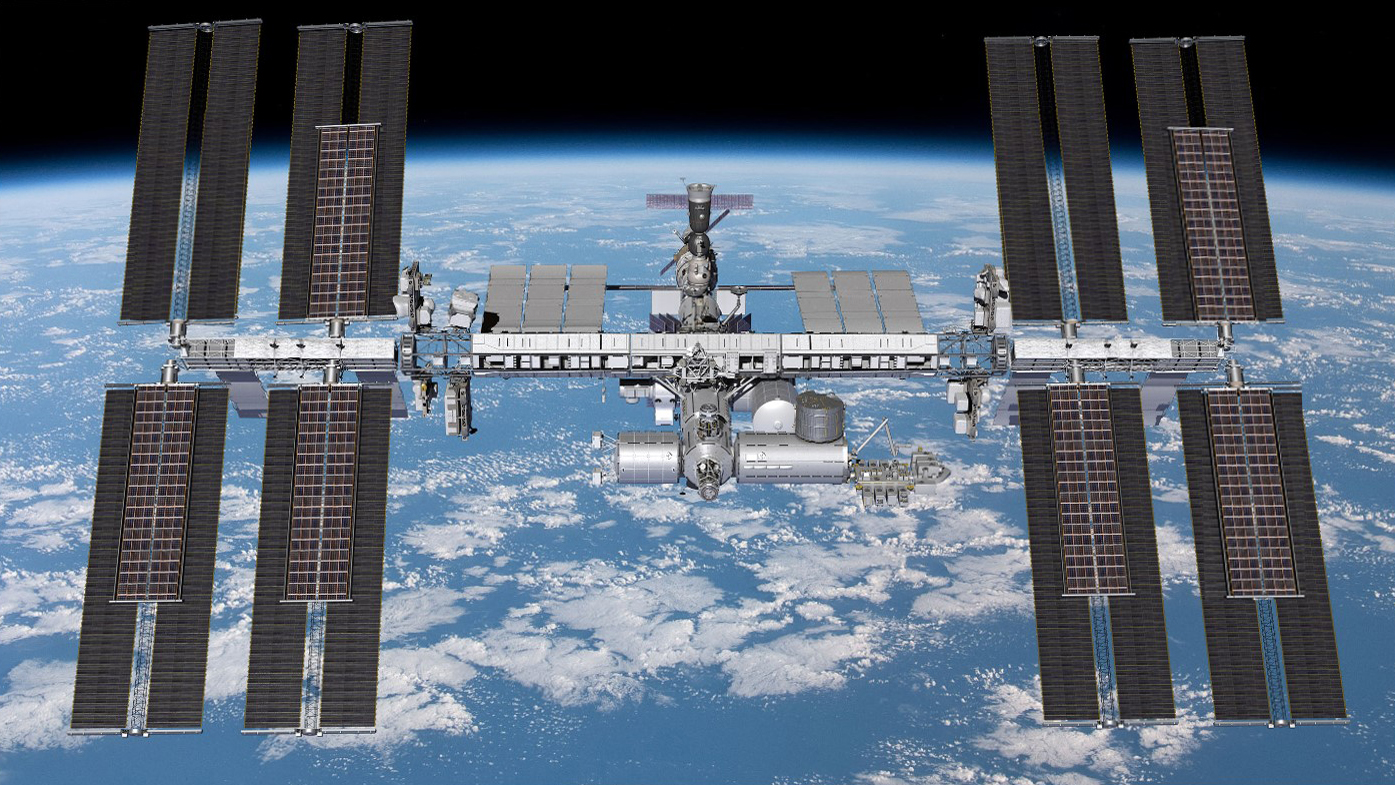Astronauts on spacewalk deploy first roll-out solar array to boost power for station
Two astronauts working outside the International Space Station successfully rolled out a new type of solar array, providing the orbiting outpost with its first power boost in decades.
NASA astronaut Shane Kimbrough and French astronaut Thomas Pesquet of the European Space Agency conducted a six-hour and 28-minute extravehicular activity (EVA) on Sunday (June 20), to finish the installation and deployment of the first International Space Station (ISS) Roll-Out Solar Array (iROSA). The two Expedition 65 crewmates resumed work where they had left off on a spacewalk on Wednesday (June 16), by overcoming an interference issue that initially prevented them from unfolding the array fully.
"Yeah! It has been engaged! Woohoo!" Pesquet exclaimed after the array was aligned with its mounting bracket. At the advice of Mission Control, Pesquet and Kimbrough used wire ties and tethers to assist in fully extending the 20-foot-long (6 meter), 750-lb. (340 kilograms) assembly.
Video: Watch astronauts roll out new solar arrays in spacewalk

The astronauts then secured bolts and ran cables to the new array, the latter tying the iROSA into the same power channel (P6/2B) as the 20-year-old legacy array that it was installed to augment on the far left (port) side of the station's backbone truss. For safety concerns, the spacewalkers waited until the space station was in a nighttime pass to connect the electrical cables.
The station's eight original arrays have begun showing degraded power output as they have exceed their 15-year design life. The new roll-out solar arrays are being installed in front of, and partially overlaying, six of the older arrays. When used in tandem, the upgraded system will be capable of increasing the station's electricity supply by 20 to 30 percent.
"These new ISS Roll-Out Solar Arrays are pretty fantastic. It is pretty incredible to see the material they are [made] out of, for one," Kimbrough said in a recent NASA interview. "They are this lightweight, flexible composite blanket material that can get stowed very compactly, but when it is rolled out and deployed, it can bring in a lot of sunlight, which in our case will give us a lot of power for the station."
Breaking space news, the latest updates on rocket launches, skywatching events and more!

The first pair of the new arrays were launched in the unpressurized "trunk" of the SpaceX Dragon cargo spacecraft that arrived at the space station on June 5. The IROSAs were built by Deployable Space Systems (DSS) and were configured for launch and installation on the station by Boeing.
Unlike the legacy arrays, no motor was needed to deploy the iROSA to its 63-foot (19 meter) length. After Pesquet released two final bolts, the potential energy held by the array's rolled-up carbon composite booms was enough to unroll the array. The entire process took about six minutes.
"Good news you two. As you can probably see most of what we can see, we are tracking a full and good deploy of that solar array," Jenni Sidey, a Canadian Space Agency astronaut serving as the ground intravehicular officer in Mission Control in Houston, radioed Pesquet and Kimbrough once the deployment was complete. "So well done both of you."
"Congratulations to everyone involved in that project," replied Pesquet.

In addition to ensuring that the space station has enough power, the iROSAs are also serving as a test for NASA's Artemis Gateway to be deployed in orbit around the moon. The Gateway's planned arrays will be longer and be deployed remotely but otherwise will use the same technology from the same company.
Sunday's EVA was originally intended to install and deploy the second iROSA on the P6 truss' 4B power channel array. With the first iROSA now extended, Kimbrough and Pesquet were able to work on some "get-ahead" tasks for their next spacewalk together, now scheduled for Friday (June 25) to install and deploy the second array.
This was the 240th spacewalk in support of space station assembly. The EVA, which began at 7:42 a.m. and ended at 2:10 p.m. EDT (1142 to 1810 GMT), was the eighth for Kimbrough and the fourth for Pesquet. The pair arrived at the station as members of SpaceX's Crew-2 aboard Dragon Endeavour in April.
Kimbrough has now spent 52 hours and 43 minutes on spacewalks. Pesquet has logged 26 hours and 15 minutes.
Follow collectSPACE.com on Facebook and on Twitter at @collectSPACE. Copyright 2021 collectSPACE.com. All rights reserved.
Join our Space Forums to keep talking space on the latest missions, night sky and more! And if you have a news tip, correction or comment, let us know at: community@space.com.

Robert Pearlman is a space historian, journalist and the founder and editor of collectSPACE.com, a daily news publication and community devoted to space history with a particular focus on how and where space exploration intersects with pop culture. Pearlman is also a contributing writer for Space.com and co-author of "Space Stations: The Art, Science, and Reality of Working in Space” published by Smithsonian Books in 2018.In 2009, he was inducted into the U.S. Space Camp Hall of Fame in Huntsville, Alabama. In 2021, he was honored by the American Astronautical Society with the Ordway Award for Sustained Excellence in Spaceflight History. In 2023, the National Space Club Florida Committee recognized Pearlman with the Kolcum News and Communications Award for excellence in telling the space story along the Space Coast and throughout the world.
